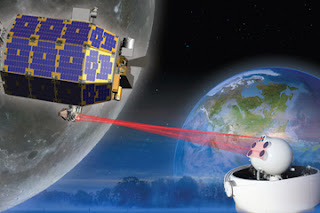 |
| Nasa Development |
The house agency is functioning exhausting to develop laser-based house communications systems, that officers say area unit key to making sure speedy and correct transmission of knowledge from orbiter round the system.
"With missions developing additional extremely
elaborate science and bigger volumes of information, radio-based communication links are often overpowered by the sheer quantity of information being pushed to the bottom, providing a requirement for higher information rates that may solely be achieved with optical communication," NASA officers wrote in an exceedingly description of the agency's optical device Communications Relay Demonstration mission (LCRD), that is slated to take off in Gregorian calendar month 2017.
Demonstrating optical device Communications
LCRD can launch to orbit as a hosted payload on an advertisement orbiter developed by the corporate house Systems/Loral.
The experiment's 2 optical modules can use lasers to send data to 2 ground stations, one in Golden State and one in Land of Enchantment, at rates of up to one.25 gigabytes per second. LCRD can operate for a minimum of 2 years, with the aim of demonstrating the long viability of a space-based optical device communications system.
LCRD can leverage technology that has already shown its stuff in house. The mission relies heavily on the satellite optical device Communications Demonstration experiment, or LLCD, that launched to the moon aboard NASA's satellite Atmosphere and mud surroundings mortal orbiter last month.
LLCD has already set a record, employing a periodic ray of light to send information 239,000 miles from satellite orbit to Earth at a rate of 622 megabits/second. The previous record from the moon had been one hundred fifty megabits per second, achieved by NASA's satellite intelligence artificial satellite (LRO), aforesaid physiologist Edwards, chief communications systems engineer at the house agency's Robert Hutchings Goddard house Flight Center in belt, Md.
The LLCD system is additionally additional economical than the radio-frequency approach used by LRO and alternative orbiter, requiring considerably less mass and power, Edwards additional.
"So we're very excited concerning what this implies for the longer term," he aforesaid Oct. 23 throughout a presentation with NASA's Future In-Space Operations social unit.
The method Forward
NASA officers read LLCD and LCRD as steps toward developing a form of "high-speed Internet" of house, which might modify probes to transmit information ten to a hundred times quicker than they are doing currently.
"We believe laser-based communications is that the next paradigm shift in future house communications."
Such a capability may enable the streaming of live, high-definition video from faraway planets like Jupiter and Saturn, officers say. And it'd be helpful nearer to home further, probably providing the backbone of NASA's next-generation following and information Relay Satellite network,or TDRS.
TDRS has been serving to relay information from NASA orbiter to the bottom since 1983, once the primary satellite within the constellation launched to Earth orbit aboard the ballistic capsule competitor.
Optical communications may provide the system a giant upgrade, however the technology has to be vetted by experiments like LCRD 1st, Edwards aforesaid.
"NASA is presently conducting a study on what future TDRS orbiter ought to appear as if, what options they must have, wherever they may be set, what the general design [should be], things like that," he said. "One of the items that we tend to're Associate in Nursing attempt to try to to is ensure we dot all the i's and cross t's with regards to understanding what it'd go for place an optical comm service on there."
Challenges Ahead
While optical communication offers several benefits, the technology poses some challenges further. one in every of these is its value, that remains comparatively high at the instant, Edwards aforesaid.
"What we're attempting to try to to is to commercialize this to work out the way to drive the price down," he said.
"We have a method that we're presently execution that we predict can create this cheap within the future."
Another issue is inform accuracy, since optical device beams area unit terribly tightly targeted. for instance, LLCD's beam covers simply three.6 miles of ground space once it reaches Earth's surface, that means the system should be lined up fairly exactly with a ground station for information to be received. (This isn't abundant of a priority with radio-frequency communications, that area unit far more distributed.)
"As you go farther out into part, it becomes additional problematic," Edwards aforesaid.
Laser systems designed to figure on the far side the Earth-moon system would ought to significantly larger and additional powerful, with larger ground-based receivers to intercept their beams, he added. to assist lay the inspiration for such technology, ANd Space Administration NASA hopes to launch an optical-communications demonstration mission to part within the comparatively close to future.
"That work is being undertaken by the reaction propulsion Laboratory, on one thing known as the part Optical Terminal," Edwards said. "That's presently in technology development, in thought development. we do not have Associate in Nursing actual flight project nonetheless, with a committed funding supply and a committed satellite. however we tend to hope to fly one thing shortly within the decade."
No comments:
Post a Comment